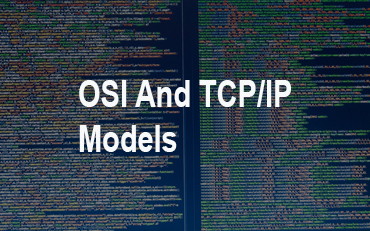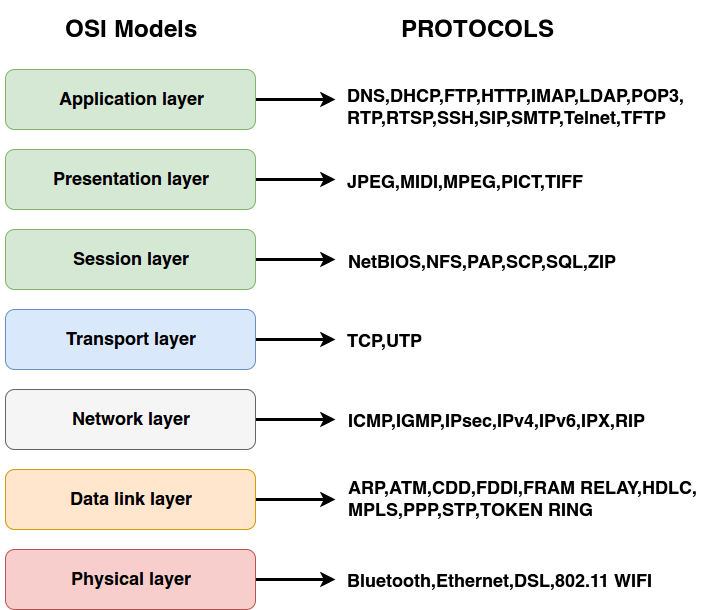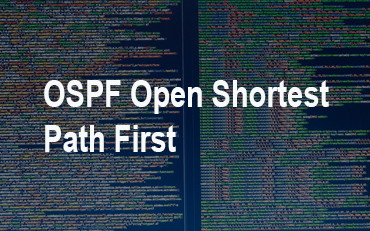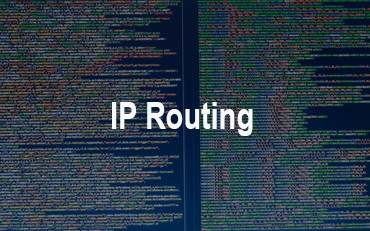OSI And TCP/IP Models
OSI reference model
OSI stands for Open Systems Interconnection. It is developed by ISO which is stand for International Organization of Standardization. OSI is a 7 layer architecture.
osi model explained
Description of layer :
Application layer
The Application Layer is the seventh layer in OSI network model.Real traffic data will be often generated from the Application Layer.It is responsible for providing networking service to the user, and also known as desktop layer. Port Number used to Identification of service . Port are entry and exit point of layer.
The functions of the Application layer are :
Network Virtual Terminal
FTAM-File transfer access and management
Mail Services
Directory Services
Presentation layer
Presentation layer is used to convert the data into standard format and transfer the data in the format that will be accept by application layer.
Example : ASCII, EDCDIC, JPEG, MPEG, BMP, MIDI etc.
It performs these task also such as
Encoding – Decoding
Encryption – Decryption
Compression – Decompression
The functions of the presentation layer are :
Translation : For example, ASCII to EBCDIC.
Encryption/ Decryption : Data encryption translates the data into another form or code.
Compression : It compress the data which need to transmitted over the network
Session layer
Session layer is responsible for establishing and maintaining the session for communication. It terminate the session after communication.
Session ID work at session layer
Example :
RPC : Remote Procedure Call
SQL : Structured Query Language
NFS : Network File System
Transport layer
Transport layer actual transmission of the data is done here it is also known as the layer of end-to-end delivery of the data.
It is also called as the Heart of OSI model. The data in this layer is in segment format.
Data in the Transport Layer is called as Segments.
Transport layer is operated by the Operating System. It is a part of the OS .
Segmentation : The process of dividing the data into smaller part is called segmentation. Every small part are unit known as one segment.
Transport layer perform the following task as well
Identification service.
Multiplexing and Demultiplexing
Segmentation of data.
Sequencing and Reassembling.
Error correction.
Flow Control => means control the bandwidth and speed of transmission.
| TCP | UDP |
|---|---|
| Connection oriented | Connection Less |
| Reliable | Unreliable |
| Slower | Faster |
| Ack – Port no. 6 | Ack Port no. 17 |
| e.g. HTTP,FTP,SMTP | e.g. SNMP,DNS,DHCP,TFTP |
Network layer
Network layer is responsible for providing best part for data to reach next destination. Logical address work on this layer.
Its is essential for providing source to destination delivery of packet.
It is divided into two part
1) Routed protocol : IP,Ipx and Appletalk
2) Routing protocol : RIP,IGRP, EIGRP,OSPF
The functions of the Network layer are :
- Routing: Its determine the best route form source to destination. This function of network layer is known as routing.
- Logical Addressing: It is unique address given to internetwork device for identification. The sender & receiver’s IP address are placed in the header by network layer.
Data link layer
Data link layer is used to handle the data transfer between network layer and physical layer. The data in this layer is in form of frame.
Data Link Layer is divided into two sub layers :
i) Logical Link Control (LLC)
ii) Media Access Control (MAC)
i) Logical Link Control (LLC)
Error detection and flow control
Talks about WAN Protocls
E.g. PPP , Frame Relay.
ii) Media Access Control (MAC)
Talks about physical address and it have 12 digit Hexadecimal number .
Also responsible for error detection
Primary responsibility of MAC Data Encapsulation and Media Access Control
Data Encapsulation includes frame Assembly.
The functions of the data Link layer are :
Framing : Framing is a function of the data link layer.
Physical addressing : It adds physical addresses (MAC address) of sender and/or receiver in the header of each frame.
Error control : It control the error by re transmitting damage or lost frame when detects.
Flow Control : It control the flow that is the amount of data to be sent.
Physical layer :
Physical layer is used to establish and terminate physical connection to a communication medium. It also define the electrical, mechanical specification likes cable connection and signalling option of medium and also responsible for procedure check.
Data in this layer is in the form of electrical pules if it is coaxial cable and twisted pair cable, and if the cable is fibre optic the data will be in the form of light
Devices : Hub, Repeater, Cable modem etc.
The functions of the physical layer are :
Bit synchronization
Bit rate control
Physical Topologies
Transmission mode
TCP/IP model (Transmission Control Protocol/Internet Protocol )
The TCP/IP model is a short version of the OSI reference model.Following are the different layer of TCP/IP
- Application Layer
- Transport Layer
- Internet Layer
- Network Access Layer
Advantage of TCP/IP model
operated independently.
It is scalable.
It supports a number of routing protocols.
Disadvantage of TCP/IP model
In this, the transport layer does not guarantee delivery of packets.
The model cannot be used in any other application.
osi model protocols and TCP/IP
Total number of Port – 65535
Reserve port -1023
Open Client Port – 102 4 – 65535
FTP port number – 21
HTTP port number – 80
SMTP port number – 25
Telnet port number – 23
TCP port number – 69
TCP port number – 6
UDP port number – 17
CRC – cycle Redendency check
You May Also Enjoy Reading This …








